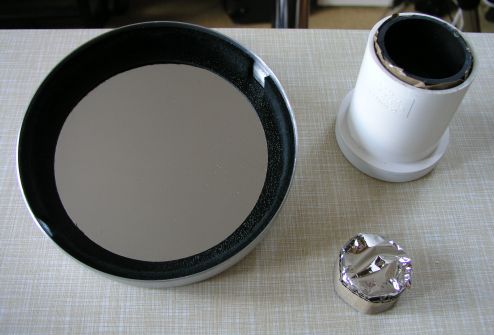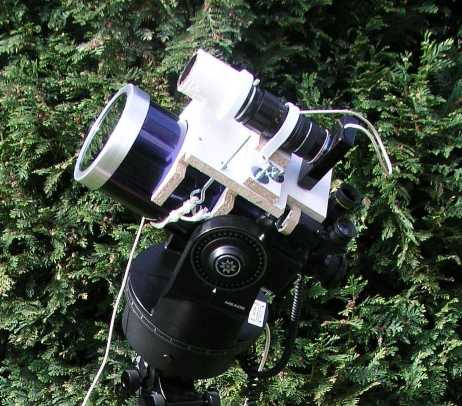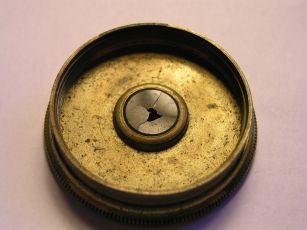

WARNING! The Sun is extremely dangerous. Looking at it
with any sort of optical aid will result in instant blindness.
Never use a
Sun Cap
This is how I do it.
You have probably seen the trick of setting fire to paper using a magnifying glass. Any telescope is a very big magnifying glass and, if you put your eye to the focus of the Sun, you will burn a hole in it.
The essential thing is to stop all that energy getting into the telescope in the first place. Not only will that protect your eye (or your CCD camera) but also the telescope itself. Refractors will come to no harm being pointed at the Sun, but reflectors may be damaged. Mirrors are not 100% perfect reflectors and most reflecting telescopes use a secondary mirror not far from the focal point of the main mirror. Also Schmidt-type telescopes (those with a corrector plate at the front) are closed tubes and the air inside them may get quite hot.
It is important not to forget the finder 'scope too. This should either be covered completely or equipped with its own solar filter. Personally I find the finder useful, so I made a filter for it.
This means covering the entrance to the telescope with something that will block 99.99999% of the light that falls on it. Solar filters designed for viewing are coated to a neutral density of 5, which means they pass only a 100,000th part of the incident light. At least two types exist and I have both.
| Firstly, I have a glass filter from Thousand Islands Optical which fits over the front of my Meade ETX125 telescope. Secondly, I have a home-made filter made from Baader solar film which fits over my SLR lens that I use for whole-sun images. I have also made a small one to cover the finder. The Baader film is not visible in the SLR filter as it is well down inside. This filter was made from two drain-pipe fittings; I was lucky, the outer one fits my lens perfectly. The filter for the finder is made of cardboard and is rather delicate and I have to ensure it is covering the finder perfectly each time I use it. As you can see the film is not perfectly flat. For a finder this obviously doesn't matter, but in fact it doesn't matter too much for the main optics either. The film is very thin and has perfectly parallel faces, so small wrinkles really don't matter. The one in my home-made SLR filter is slightly wrinkled and you can see the pictures taken through it on my Sun page. |  |
| Here you can see the filters fitted to the telescope. This is the set-up I used to image the transit of Mercury in May 2003 and the transit of Venus in June 2004. | 
|
The Baader film is very much cheaper than the glass filter, so you may wonder why I bought the glass one. Well, for one thing I didn't know about the Baader film at the time, and I wanted to be absolutely safe when viewing the Sun. My eyesight is worth the cost of the best.
NEVER EVER use a sun cap. This is a dark filter that used to be provided with
small refracting telescopes, and for all I know may still be, and which screws over the eyepiece. I have one of
these which came with a very old, brass telescope given to me when I was a boy. Not knowing any better, I used
it. But see what happened to it; fortunately I was not looking through it at the time. It doesn't show in the
picture, but in fact there is a hole right through it.

Finally
A problem imaging the Sun is that I cannot see the LCD screen on my laptop in bright light.
Some people cover themselves with a blanket, but I find a cardboard box works well and is more convenient.
(The head-mounted ear coverings are not essential, but they reduce the sunburn.)
The Meade ETX125 can just be seen in the background. I have to sit close to the telescope so
that I can reach the keypad whilst looking at the screen.
Picture courtesy my son-in-law with his new digital camera....